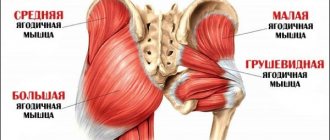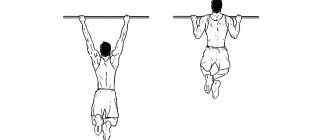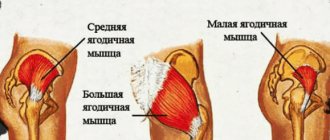Understanding how much you need to exercise in the gym allows you to build an effective workout plan, which will definitely affect your results.
Some athletes believe that training to failure is the best option, so their visit to the gym is delayed by 1.5-2 hours.
Imagine their surprise when they discover colleagues who have achieved the same effect, but study for no more than 1 hour. You can find the “golden mean” only by understanding the physiology of the training process.
A little theory: research on the duration and frequency of training
Frequency and duration are key factors in improving the results of any training. Until recently, athletes believed that one long workout every 7 days on any muscle group gave the greatest effect.
However, recent studies have shown that increasing the number of exercises is more productive, and this is primarily due to the process of muscle protein synthesis.
During training, the muscles are subjected to stress, as a result of which, at the end of training, muscle protein is synthesized most actively.
And here it is worth mentioning the key point, namely the preparedness of the athletes.
The fact is that the period of combining amino acids into protein differs significantly between experienced athletes and beginners. For the former it takes 16-18 hours, but for the latter it can last up to 2 days.
Important! The frequency of training is directly related to the experience of the athlete. For beginners, 1-2 visits to the gym are enough to actively grow muscle mass; trained athletes will find it more difficult to achieve hypertrophy with such a frequency of visits.
As for the duration of the training, it is directly related to changes in hormonal levels during sports. It has been proven that after 45 minutes of intense training, the level of cortisol in the human body increases, which provokes the onset of catabolic processes that destroy muscle tissue. Therefore, trainings that last 40-45 minutes are considered the most productive and safe. The maximum possible time is 1 hour.
Be sure to watch: Lose weight in the gym: the dream or reality of every girl. Training program in the gym for girls. How to use exercise equipment in the gym. Training program for the gym for men: creating an effective set of exercises.
How do pharmacology and stimulants affect the duration of training?
After taking pharmacological drugs, many athletes, even after two hours in the gym, practically do not feel tired.
In bodybuilding, pharmacological drugs (steroidal and non-steroidal), as well as isotonics and pre-workout complexes, are widely used. They have different principles of action, but they all have one thing in common - the ability to increase endurance and strength. For this reason, many athletes, even after two hours in the gym, practically do not feel tired, but it is not recommended to exercise for more than 60 minutes:
- Hormones continue to be produced according to the same principle as without drugs (anabolic steroids are an exception, since they enhance the production of male sex hormones);
- Pharmacological non-steroidal drugs for fat burning often weaken the body, especially during drying, and prolonged physical activity can lead to fainting (for example, Metformin, Clenbuterol, etc.).
While taking steroids, training should be as intense as possible, but do not forget about breaks and recovery, which play a key role. Beginners are not recommended to use such drugs.
How often should you go to the gym - the optimal number of times a week to get results?
The frequency of exercise is determined by goals. In most cases they are formulated as:
- weight loss;
- strengthening muscles and endurance;
- muscle building.
Cardio training aimed at burning body fat can be done 3 to 5 times a week, as it is quite easy and does not require much recovery time. Another thing is strength training. It is not recommended to carry it out more than 3 times a week, but it is necessary to ensure that after each load the muscle group “rests” for at least 72 hours.
Important! It is worth taking into account individual characteristics and type of constitution. Thus, in mesomorphs with a high recovery rate and strength sensitivity, muscle mass growth will be faster, while in ectomorphs and endomorphs the recovery process will take longer.
Training in numbers: what, who, how many?
In one of the previous articles, we discussed in detail what time is best to visit the gym. Then we clearly understood for ourselves what physical activity should be performed at this or that time of the day. Today we will continue the “debriefing” and find out how many times you need to go to the gym in order to achieve the best results.
Each organism is individual - some recover very quickly, while others require a long time to recover. It is very difficult for a beginning athlete to determine the supercompensation phase. Contact the specialists who work on our site. They will definitely take into account the characteristics of your body and draw up a competent training and nutrition plan. Individual training will save your time and money! Go to the individual trainers section.
When any questions arise, most people (especially young people) run to a search engine for answers. They say that the Internet has answers to all questions, but few people think about its quality and veracity. So someone once said that you need to go to the gym three times a week and away we go. Almost every resource has the same answers, as if they were carbon copies. Actually, we could not think for a long time, but just say right away: they say, comrades, go to the gym three times a week and you will be happy. But we don’t like such a superficial approach, so we will now delve into the essence of the issue very carefully and in detail.
Let’s start, perhaps, with something visual, with statistics, which tell us the following (see figure).
As you can see from the chart, most people (about 80%) go to the gym three times a week. Moreover, you can even easily guess that the evenings (from 18 to 21 hours) of Monday, Wednesday and Friday are dedicated to sports. It is precisely at this time that there is the largest influx of people in gyms and fitness centers, so there is, literally, nowhere for the apple to fall. And this trend is easily explained:
- A common habit.
- Convenient to combine with work or study.
In reality, if a person is really determined to get serious results, and not go to the gym for show, then the question of the number of workouts per week needs to be approached seriously.
When a person subjects his body to training, the various processes together can be divided into several types. There are only four of them:
- Work of the heart and blood vessels.
- Development of muscle strength.
- Endurance training.
- Development of muscle elasticity and flexibility.
Now let's look at each type in more detail.
Cardiovascular system load
This type of load provokes the development of lungs, veins and arteries, which are responsible for transporting oxygen to organs and tissues. Over time, the heart becomes more resilient and able to pump more blood with fewer contractions. As a result, your heart rate decreases, which means your heart will pump more efficiently and easily.
All exercises that use a lot of oxygen (aerobic) strengthen the cardiovascular system. And you need to pay attention to this when you create your training plan.
Developing endurance and muscle strength
As soon as you stop actively using your muscles, they begin to shrink, shrink, that is, shrink. Muscle strength is necessary for a person in any everyday situation: to lift children, carry bags, stand straight or lie horizontally. Good endurance makes it possible to perform certain actions for a longer period of time without feeling tired. All these qualities are needed in order to be mobile, agile and functional, which is especially important in old age.
It is also important to remember that active muscle tissue uses much more calories than inactive muscle tissue. So this is great news for those who want to lose weight. All exercises aimed at overcoming resistance develop a person’s muscles.
Flexibility
Flexibility is no less important than other indicators, but is often not taken into account during training. But it is precisely this that determines the degree of joint mobility. Without flexibility, a person will not be able to perform even the simplest tasks and movements. Also, due to flexibility, the risk of injury is reduced and eliminates premature lower back pain. So stretching and yoga are mandatory attributes of the training program.
All of the above is the basis for determining the volume of training and specific numbers (how much time you need to train per week).
Let's look further, so now it's time to determine the correct mechanism for building a workout in the gym.
Is it possible to train every day?
Until recently, daily training for different muscle groups was considered the norm for many athletes. However, practice has shown that neither muscle tissue nor the nervous system had time to cope with stress. As a result, the productivity of the training process decreased, and the effect of overtraining occurred.
The time required for recovery depends on several indicators:
- athlete experience (a beginner needs more, a professional needs less);
- type of muscles (small ones recover faster, large ones - slower);
- muscle groups (biceps and triceps can be trained more often, legs - less often).
The following recommendations resulted from research and practical experience:
- Beginner athletes – 3 times a week.
- Experienced athletes – from 4 to 5.
At the same time, you should not load the same muscle groups more than 2 times a week.
Frequency of visits to the gym depending on experience in bodybuilding
Experience also matters when choosing the frequency of classes. The different weights that experienced and beginner bodybuilders work with, as well as the difference in the available muscle mass and the load received, means that beginners may visit the gym much more often than their more experienced gym mates. In the case of working with a large muscle group, a beginner can fully recover in thirty-six to forty-eight hours.
Experienced bodybuilders can give a greater load, and due to greater muscle mass, the recovery process is delayed for a longer period. Therefore, such athletes often choose to train isolated muscle groups, which allows one muscle group to be given a break from exercise for up to one week. Such an athlete can visit the gym every day or every other day, but working with isolated groups gives him the time necessary for rest and recovery.
Best hours for sports: morning, afternoon, evening
Human physiology and vital activity are associated with the phenomenon of circadian rhythms. At its core, these are fluctuations in natural biological processes, for example, body temperature, hormone levels, and blood pressure. Human activity, including motor activity, depends on these indicators.
The answer to the question of when is it better to go to the gym: in the morning or in the evening, is closely related to the type of training. Thus, in the morning hours there is a significant production of cortisol, which is responsible not only for quickly waking up, but also for mobilizing strength during physical activity. The best option for exercise at this time is cardio training. Due to cortisol, metabolism accelerates and energy expenditure increases significantly.
Some athletes prefer to go to the gym in the afternoon. And this is also facilitated by circadian rhythms. During the period from 16.00 to 18.00, most people experience a slight increase in body temperature. As a result, the muscles are warmer, more elastic and prepared for work. At this time, anaerobic exercise will be effective, including due to increased endurance and reduced risk of injury.
In the evening, you should not resort to heavy muscle-building exercises or intense aerobic exercise. This will affect the quality of sleep and disruption of the immune system. Most often, it is at this time that people do relaxing yoga or breathing exercises.
How to avoid overtraining?
This is an equally important topic compared to how often to exercise. First of all, you need to monitor your progress. If you stop progressing in at least one exercise, this may indicate that you are close to overtraining.
In the example we considered above, this is what happened, because the builder noticed that he had stopped improving his results in the bench press. If a similar situation happened to you, then you should rest. Here are the three main symptoms of overtraining.
We recommend reading: Supersets for shoulders
- The working weight in exercises does not increase. To progress, you need to gradually increase the load. However, for this, the body must fully recover so that you can work with heavy weights.
- The number of repetitions or the time of static holding of projectiles does not increase. If the working weight does not increase, then the number of repetitions or the time of static holding of the projectile should increase.
- You spend more time doing the same workout. The effectiveness of training is closely related to the concept of intensity, which is measured in units of time. Simply put, if it took you longer to do an activity you did a few days ago today, then the intensity has dropped.
How long should the workout last?
The question of what time is best to go to the gym is related to the question of how long you can exercise. Here it is worth turning again to physiology. During physical activity, the body produces 2 types of steroid hormones: catabolic and anabolic. The first are represented by testosterone, somatotropin and insulin. Their task is to restore muscle fibers and build new muscle tissue cells.
The second group is cortisol and glycogen, which increase blood glucose levels and “stimulate” metabolism. Glycogen, at its core, is a storage facility for glucose; it is found both in the muscles and in the liver. During the first 20 minutes, the body takes it from muscle tissue, and then begins to “extract” it from the liver.
Important! After 40-45 minutes of active training, cortisol levels increase, which in excess is more harmful than beneficial. It reaches its maximum values at 55-60 minutes of training. At the same time, blood pressure begins to rise and immunity deteriorates. Intense production of cortisol for more than 60 minutes has the opposite effect, as muscle tissue begins to break down.
Therefore, sports and medical experts strongly advise not to overtrain and not work in the gym for more than 45-60 minutes.
How long after the start are results visible?
Sport is not plastic surgery, where immediate results are visible immediately after the operation. The visual results of regular exercise will become noticeable only after 10-12 weeks of training. At the same time, you need to train at least 3 times a week for the results to become noticeable.
If your goal is to lose weight, then it makes sense to alternate cardio with moderate strength training. In the case of gaining muscle mass, it is necessary to draw up a plan taking into account the muscle recovery period, which should not be less than 72 hours.
In both cases, you will need to organize a balanced diet that meets the goals of the exercise.
What results can you realistically achieve?
Despite the fact that the most obvious results can be summed up only after 3 months, intermediate results can begin to be tracked much earlier.
So, after two days, the body, unprepared for sports, will make itself felt with unpleasant muscle pain. To minimize pain, you must not forget about the warm-up, which reduces the risk of injury for beginner athletes, and the final stretch, aimed at facilitating the process of muscle tissue recovery.
These pain sensations bother you after the first 2-3 sessions, after a couple of weeks, all muscle pain will go away. The main thing is not to stop training during this period.
Physical well-being will improve significantly 4 weeks after starting to visit the gym. It will become easier to get up in the morning, shortness of breath will disappear, muscles will stretch better, and most exercises will be easy to do. During this period, visceral fat, which is located near the internal organs, is burned. After this, the turn will come to the subcutaneous.
After 2 months, the body will gradually begin to change shape, the risk of heart disease will decrease, as well as blood sugar levels, which will significantly reduce the possibility of developing diabetes.
After 3 months, it will be possible to visually evaluate the results achieved. They will be noticeable to others. Muscle relief will appear or improve, and some of the subcutaneous fat will disappear. The silhouette will become slimmer, fitter and more beautiful.
Pro Tips
Ekaterina Usmanova, current Russian fitness bikini champion, video blogger
Ekaterina strongly recommends supplementing strength training with cardio blocks, combining everything into interval training, which, while maintaining the proper pace, should not exceed 1 hour.
Denis Borisov, video blogger, author of articles on bodybuilding, one of the creators of the Fit4life.ru project
Denis recommends that beginners who are committed to the process of gaining muscle mass should exercise no more than 3 times a week, for at least 1-1.5 years. In addition, the duration of training, depending on the plan, should vary from 30 to 60 minutes.
Ilya Timko, fitness trainer, creator of the website Tvoytrener.ru
“The more often you train, the shorter the sessions should be,” says Ilya. So, for example, if the training was 2 times a week for 1.30, and then the athlete switched to 4 classes a week, then the training time should be reduced by about 30%, that is, to 60-70 minutes maximum.”
Practical advice
Some people who have just started working out in the gym make a number of mistakes:
- Exercising too much (more than 1 hour);
- They do little (less than half an hour);
- They use a large number of simulators and equipment (more than 5-7 units).
Long-term training negatively affects the state of the hormonal system responsible for the athlete’s progress.
If short workouts and chaotic use of more than seven exercise machines in one visit are unlikely to bring visible results, then overdoing it in terms of duration of classes can cause great harm:
- The condition of the muscular system deteriorates. During training, the body experiences stress, and muscles are damaged, because without this their growth is impossible. That is why they need recovery, on which the success of their studies also largely depends. If you exercise too often and for a long time, the muscular system will not have time to recover;
- Lack of oxygen. Energy production during weightlifting exercises lasting less than two minutes is performed without oxygen. Low-intensity long-term training, on the contrary, actively uses it to burn fat and glycogen reserves;
- Overtraining. This is the main enemy of athletes: until the muscles are at least partially restored, there is no point in going to the next workout. This condition is usually accompanied by catabolic processes to a greater extent than with moderate physical activity.
The duration of the workout depends mainly on the program: for example, aerobic training for fat burning should last from 40 to 60 minutes, while training with barbells and strength training equipment should be limited to 45 minutes. Pre-warm-up is not included in the total duration of the lesson.
The most popular are two training systems:
- Split: individual muscle groups are worked out in one session;
- Fullbody (circuit training): involves working on all muscles.
In the first case, most often a large number of repetitions and a minimum of approaches are performed, between which there is a long rest (up to 1 minute), and in the second the opposite is true: the frequency of repetitions decreases, but the approaches increase, and the rest between them is reduced to 10-20 seconds. This also needs to be taken into account when building a training program.
What beginners need to know:
- Using a large number of simulators does not guarantee good results. Normally, three basic and two isolating exercises are enough for a workout;
- Long-term training negatively affects the state of the hormonal system responsible for the athlete’s progress: they activate catabolism and prevent anabolism;
- Short sessions (less than half an hour) do not have a significant impact on the result, because the body does not produce enough hormones and other substances to quickly build muscle tissue and burn fat, and the muscles themselves do not receive optimal load.
Main conclusions
The frequency and duration of training directly depends on the physiology of a person and his goals:
- The optimal number of trips to the gym: no more than 3 times for beginners and no more than 5 times for professionals.
- The duration of sports should not exceed 1 hour.
- Daily training is harmful to both the muscular and nervous systems.
- The first results of working on yourself will become noticeable after 10-12 weeks.
The effectiveness of training depends not only on the effort put in, but also on a balanced, well-chosen diet.











